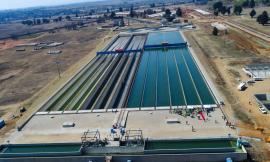
Rand Water has been hailed for completing Phase 1 of the 150 megalitres a day (ML/d) Station 5A filtration plant on schedule.
The plant, which is one of Rand Water’s flagship projects, will bring assurance to the sustainability of water supply to the Gauteng province and surroundings.
Water and Sanitation Minister Senzo Mchunu and Deputy Minister David Mahlobo, joined by the Emfuleni Mayor Sipho Radebe, Rand Water Board Chairperson Ramateu Monyokolo, and Rand Water Chief Executive Sipho Mosai, have commissioned the first part of the mega water project situated at the Zuikerbotch Water Treatment Works outside Vereeniging in the Vaal.
Mchunu said there is a great need to increase infrastructure and to ensure that operation and maintenance are undertaken to existing infrastructure, and that Rand Water is doing exactly that.
The Minister commended Rand Water in its forward thinking and keeping its eye on its mandate.
“Whether it is in terms of actual water supply or the maintenance of water and sanitation infrastructure, Rand Water has continued to ensure that it keeps its eye on the mandate. Those of you doubting our commitment as DWS to infrastructure development, forget it. We're ahead of the curve. It is not a matter of when, but rather where are we today,” Mchunu said.
Rand Water has built the completely new purification plant at the existing Zuikerbosch Plant, referred to as Station 5, in an effort to augment water supply, ensure sustainable water supply, and to meet current and future demands.
The Station 5 plant is divided into two phases (5A and 5B). The completed Phase 1, Station 5A, will produce 150ml/d of potable water, adding to the current available supply by Rand Water to its customers, including Gauteng municipalities, parts of Free State, Mpumalanga and North West provinces, as well as industries.
Upon completion of Phase 2 (Station 5B) at the end of 2024, the plant will add another 450 ML/d, totalling to 600ML/d of water to users.
The purification plant is part of the Rand Water's capital expenditure projects and seeks to bring more capacity to the water utility’s system to ensure water security to the provinces it supplies.
Speaking at the recent ribbon cutting to officially commission Phase 1 of the newly built Section 5A purification plant, Mchunu emphasised the need for new water infrastructure to address current and future demand of water in the province.
He said the commissioning of Station 5A is demonstrative of the department’s seriousness about increasing infrastructure capacity.
Mchunu said while the mandate of the sector was to ensure access to clean drinking water and to manage water resources, “one cannot have access to water without the proper infrastructure”.
Since 2019, the Station 5A project has created 871 job opportunities, providing employment to people with diverse skill levels, ranging from unskilled to semi-skilled, and skilled labourers.
The project has also supported more than 48 Small, Medium and Micro Enterprises (SMMEs) with small work packages from the core activities of the 26 projects.
Vision 2030 infrastructure build programme
Monyokolo said the project is part of Rand Water’s Vision 2030 Infrastructure Build Programme and that they are well within their timelines and in some instances, they are ahead.
“… This additional 150ML/d Station 5A programme ensures that there is more than enough water for all our customers and therefore consumers.
“As a board, we have a full and comprehensive understanding of the importance of infrastructure upgrading and refurbishment to ensure uninterrupted bulk water supply to our customers. As we celebrate the 120th year anniversary of our existence, we recognise and embrace inherent challenges that we continue to turn into opportunities,” Monyokolo said.
Monyokolo also noted some of the challenges faced by the water utility in the implementation of its CAPEX [capital expenditure] projects, which include population growth in its areas of supply, vandalism of infrastructure, encroachment on servitudes, quality of raw water, and non-payment of invoices by customers.
“The porous municipal water reticulation infrastructure also creates a simulated shortage. We are working hard to assist and collaborate with municipalities through the capable leadership of our Minister to mitigate this challenge.”
In February this year, the water utility launched the 210ML/d Vlakfontein Reservoir in the City of Ekurhuleni. The reservoir is post-tensioned concrete, the biggest in the world and is part of the Mapleton Booster system augmentation programme. – SAnews.gov.za


